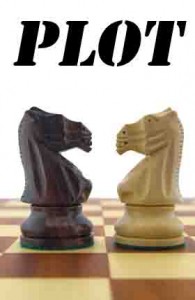I am plotting Act 2, and the terror of the empty page is hitting, take two.
So, I’m going back to some previous posts about plotting to see what they will tell me about plot, especially the middle of this novel.
In 9 Ways of Looking at Plot, I looked at various ways to plot; in 29 Plot Templates, we looked at specific types of plots. How do these plot paradigms handle act 2? I won’t reprise all of them, just those that have a lot to offer for Act 2.
- Hero’s Journey: One of my favorite plot paradigm’s is the Hero’s Journey, a set of archetypical steps that a hero takes on a quest. Act 1 sets up the quest, while Act 3 shows the hero’s victory. What happens in the middle. Here are the stages:
- Crossing the First Threshold – committing to change
- Tests, Allies, Enemies – experimenting with 1st change
- Approach to the Inmost Cave- preparing for big change
- Supreme Ordeal – attempting big change
- Reward – consequences of the attempt
- The Road Back – rededication to change (Start of Act 3)
Basically, it’s a study of character. What are the challenges faced by the hero, especially inner challenges; who helps him and who tried to defeat him; how does the hero make it through the worst possible challenge? It asks you to step back and find out what is the character’s biggest inner challenge; then deliver that with emotional impact.
- Snowflake or Branching Structure: The Randy Ingermanson’s Snowflake Method, and How to Write a Damn Good Novel by James N. Frey advice writers to start with a single conflict resolution and subdivide that endlessly until you get to the level of plot you want. This type of plotting moves from general to specific, without stopping to look back at the general.

The spines of palm leaves were used to support this arch of sand--almost a perfect sandcastle. But without the right supporting structure, it sags badly and is in danger of falling apart. Likewise, your plot needs a solid structure.
- Snowflake + Important Points Paradigm. Syd Field (writing mostly about screen plays but with huge application for novels) basically advises a Snowflake approach to writing plot, but overlays a paradigm that points to important events and connections among those events. For Field, if you know the beginning and the end, the big scenes at the end of Act 1 and Act 2, and the midpoint–well, the rest is just connecting the dots.
- Quest. In this character oriented story, the protagonist searches for something and winds up changing him/herself. As in the Hero’s Journey, the middle must force the protagonist to face up to his/her greatest fear.
- Adventure. Plot oriented, this features a goal-oriented series of events. Act
In part 1, I covered plot patterns beginning with character or beginning with a pattern such as the Hero’s Journey. This continues the discussion of 9 ways to plot.
5. Combinations of Plot Paradigms
Many descriptions of how to write plot combine a couple of these paradigms:
Overlaid with Three Act Structure.
Syd Field: Snowflake + Important Points Paradigm. Syd Field basically advises a Snowflake approach to writing plot, but overlays a paradigm that points to important events and connections among those events. His plot points aren’t labeled with reference to the hero and his journey, but with reference to the three act structure; often, however they coincide. Field works mostly with screenwriters, so is emphasis on the three act structure comes from that.

Emphasis on Inner Plot. Peter Dunne in Emotional Structure: Creating the Story Beneath the Plot likewise has a chart of events, with a variation of the hero’s journey. Dunne, however, emphasizes the difference in the inner and outer plot, relegating most of the outer story to acts one and three, leaving act two as the character or inner plot. Same story, but with a variation when you want the story to be about two people changing each other. It won’t work, though, when the main antagonist is man v. nature or man v. himself.
To emphasize the importance of both inner and outer plots, Dunne recommends you write plot points on an index card with the outer conflict on one side and the inner conflict on the other.
Major Change at Midpoint. Another idea for patterns is from David Seigel, a screenwriting, who emphasized that at the midpoint of a story, there must be a change in the main character’s goal. It’s the understanding that interesting characters grow and their needs and wants change because of events. His classic example is from The Lion King. In the first half of the story, Simba wants to be happy; in the second half, he wants to be restored to his rightful place as king of the lions. Seigel said that without this major change, stories are ineffective. He basically falls in with the hero’s journey type structure, but puts his emphasis on this major shift of the story. (Seigel had his plot paradigm on line at one time, but it’s no longer available.)
6. Emphasis on Writing in Scenes
One other variation in writing and plotting novels is the emphasis or de-emphasis on writing in scenes. Screenplays and theater plays must be written in scenes, but novels can be fuzzier about this and still succeed. However, I think there’s value in learning to write in scenes, as it keeps a story focused better. Dwight Swain’s classic Techniques of the Selling Writer, is followed by Jack Bickham’s Scene & Structure. One of the most helpful on scene writing is Sandra Scofield’s The Scene Book: A Primer for the Fiction Writer.
When you write in scenes, it’s possible to plan every scene in a novel, as Swain and Bickham recommend. But generally, you need some other paradigm of the overall structure to do a good job of it.
7. MICE quotient
There are other approaches to plot patterns that I find less helpful; nevertheless, knowing them sometimes makes it easier to be bold in doing something different. For example, Orson Scott Card in Character & Viewpoint discusses the MICE quotient: stories are governed either by their milieu (For example, fantasy which invents and explores a new world), an idea (mysteries), a character (romance or character novels) or an event (an imbalance in the world, an injustice that must be put right). The author’s focus on one of these elements determines what actually makes it into the story.
For example, on The Lord of the Rings, it could be classed as an event story, with the Dark Lord disturbing the balance of the world order. Card argues, though, that it is rightly understood as a milieu story. The story begins in the Shire, travels through Middle Earth, and as it is destroyed by the battle, it returns to the Shire; Frodo can’t remain there, though, because he’s been too damaged by his contact with evil, and takes the boat ride with the elves across the Western Sea. If it was just an event story, the story ends with the defeat of the Dark Lord. But as a milieu story, it doesn’t end until we see the end of Middle Earth.
8. Author’s idiosyncratic plot pattern
Hero’s journey overlaid with the process of grief. Pattern can also come in the shape of any process of change or growth that a human might undergo. For example, in my novel, The Wayfinder, I used the process of grief as a structure: loss, denial, acceptance, healing, You can even combine several of these structures: the process of grief overlays the hero’s journey for a more complex structure.
Patterns can come from any other source: you can think of a novel as peeling away layers of an onion; as way-stations on a long journey; as episodes.
What plot patterns work best for you?
Books Mentioned in This Series
- Bickham, Jack. Scene & Structure
- Card, Orson Scott. Character & Viewpoint
- Dunne, Peter Emotional Structure: Creating the Story Beneath the Plot
- Field, Syd.
- Noble, June & William. Steal this Plot.
- Scofield, Sandra. The Scene Book: A Primer for the Fiction Writer.
- Swain, Dwight.Techniques of the Selling Writer
- Tobias, Ronald. 20 Master Plots
- Vogler, Christopher. The Writer’s Journey.
- Vorhaus, John. The Comic Toolbox.
Websites Mentioned in This Series
Next: Enhancing the Basic Plot
Related posts:
- Plot: Characters v. Patterns
- How to Use Scenes to Plot
- Keep the Main Plot the Main Plot






